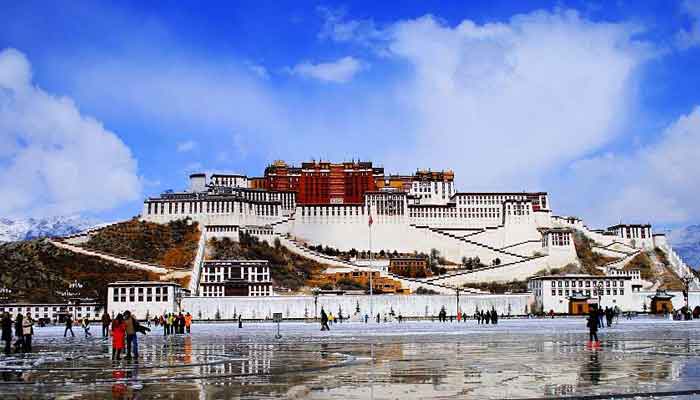What is the Tibet issue?
This scribe visited the Tibet Autonomous Region last year and found it to be a marvel of development and preservation of its original culture and heritage, contrary to propaganda of the “genocide of Tibetan Culture”. The Chinese government has attempted to develop Tibet as part of its China Western Development policy and has invested 310 billion yuan (about 45.6 billion US dollars) in Tibet since 2001. In 2009 it invested over $7 billion into the region, 31 percent more than the previous year.
The Qinghai-Tibet-Railway was completed in 2006 at a cost of $3.68 billion, leading to increased tourism from the rest of China. The Shanghai government contributed $8.6 million to the construction of the Tibet Shanghai Experimental School, where 1,500 Tibetan students receive a primarily Chinese education. A lot of effort has been made by the Chinese government for the unification of Tibetan inhabited provinces. Scientific research studies have been undertaken for the preservation of Tibetan literature, classics on Tibetology and museums. Special emphasis has been laid upon traditional Tibetan Medicine, which has been accepted as a viable field of treatment and continues to be taught not only in Buddhist monasteries, but specific departments in universities have been dedicated to it.
The biggest challenge to the Tibetan community, both inside and outside Tibet is the alleviation of poverty, which faces three major problems. The economic issues have been intensified because of the natural environment, cold, dry and Himalayan climate with limited rainfall, which affects the quality of the grasslands. There is low participation in the industrial sector, because the region is far removed from the markets and the close vicinity of India has not helped either. The regional Tibetan culture is an impediment because the Buddhists have a low motivation for pursuit of wealth.
Since President Xi Jinping has resolved to eradicate poverty from China by 2021, the Tibet Autonomous Region presents a daunting task. To meet the deadline, the Central Government has invested heavily in infrastructure development. Dual carriage highways have been built meandering through thousands of tunnels in the mountainous region with adequate rest areas, commercial and refueling facilities. The Qinghai-Tibet Highway linking Beijing has been completed. Since the Tibetan Autonomous Region offers tremendous potential for tourism, facilities have been developed for maximum benefit to accrue to the inhabitants. Cultural heritage has been preserved with national, international and UN support beckoning millions of domestic and foreign tourists.
Medical and educational capacity building has not only provided the much-needed resources but also offer employment opportunities. Vocational training centers have been a major factor in enabling the minorities to seek gainful employment after acquiring specialized skills.
Various Chinese academies of sSciences have conducted research on restoring the ecological balance and tackling the effects of global warming while maintaining economic development. A novel experience was visiting the Chinese government’s initiative to enhance the quality of life of the Tibetan nomads. They have been relocated in urban housing in newly constructed villages which amounts to one of the most ambitious attempts made at social engineering. While these nomads and their families enjoy the advantages of urban living like better housing, schools, hospitals et-al, they have been afforded neighbouring pastoral grasslands, where their horses and cattle graze while the nomads also earn living through tourism. Thus, Tibet Autonomous Region is a far cry from the propaganda of China’s detractors.
The occident has been using the “Tibet Issue” to flog mainland China and using terms like the “Sinicization of Tibet” to confuse people. The world at large is ignorant of the obvious truths and most western media outlets are basing their reports on distorted facts and unfounded claims. It is imperative to set the record straight. For more than 700 years, the central government of China has continuously exercised sovereignty over Tibet, and Tibet has never been an independent state. No government of any country in the world has ever recognized Tibet as an independent state.
Even in the first half of the 20th Century, Tibet remained a society of feudal serfdom under a theocracy, one even darker and more backward than medieval Europe. The ecclesiastical and secular serf owners controlled the personal freedom of the serfs and slaves who made up more than 95% of the population of Tibet. By resorting to extremely savage punishments, including gouging out eyes, cutting off ears, tongues, hands and feet, pulling out tendons, throwing people into rivers or off cliffs, they practiced cruel economic exploitation.
History tells us that after the liberation of China from imperialists and the establishment of the People’s Republic of China (PRC) in 1949, in 1950-51, Tibet was incorporated into PRC. Despite being impoverished itself in its post-natal phase, PRC facilitated Tibet through a range of economic, social, cultural, religious and political reforms. The wide-ranging policies have benefited Tibet, and cultural and social changes are consequences of modernization. Resultantly, Tibet’s economy has expanded; improved services and infrastructure have improved the quality of life of Tibetans, and the Tibetan language and culture have been protected.
Since its peaceful liberation in 1951, Tibet has undergone profound social changes, including democratic reform, reform and opening up, and has achieved remarkable social and economic progress.
It is ironic that in 1951, the Dalai Lama himself sent a telegram to Mao Zedong, accepting Tibet becoming part of the People’s Republic of China. In later years, reportedly at the instigation of China’s detractors, the Dalai Lama led a violent uprising in 1959, which resulted in numerous deaths. Dalai Lama fled to India and has since continued to incite Tibetans to revolt from there. There are reports which indicate that the Dalai Lama receives handsome stipends from some western powers to continue stoking the fires of rebellion and uprising. Pakistan recognizes Tibet as an integral part of China.
-
 Brooklyn Beckham Finds It 'hard' To Keep Contact With Sister Harper
Brooklyn Beckham Finds It 'hard' To Keep Contact With Sister Harper -
 New Mystery About 'Ring Nebula' Shock Astronomers: Here's Why
New Mystery About 'Ring Nebula' Shock Astronomers: Here's Why -
 Prince Harry Picks PR Photos In Fear Of ‘bald Spots’
Prince Harry Picks PR Photos In Fear Of ‘bald Spots’ -
 Saying Prince Harry Will ‘probably Be Fine Isn’t Good Enough’, Expert Speaks Out
Saying Prince Harry Will ‘probably Be Fine Isn’t Good Enough’, Expert Speaks Out -
 Inside Meghan Markle’s Plans ‘With Love, Meghan’: Season 3 And Valentines Day Specials
Inside Meghan Markle’s Plans ‘With Love, Meghan’: Season 3 And Valentines Day Specials -
 King Charles Gets Caught Between A Rock And A Hard Place For The Second Time With Harry
King Charles Gets Caught Between A Rock And A Hard Place For The Second Time With Harry -
 Dolly Parton Hints At More Music As She Marks 80
Dolly Parton Hints At More Music As She Marks 80 -
 Simu Liu Reveals How His Family Treated Him After He Started Acting
Simu Liu Reveals How His Family Treated Him After He Started Acting -
 Gwyneth Paltrow Mourns Valentino As She Calls His Death 'end Of An Era'
Gwyneth Paltrow Mourns Valentino As She Calls His Death 'end Of An Era' -
 Prince Harry Questioned Over Desires Of Becoming ‘next King’
Prince Harry Questioned Over Desires Of Becoming ‘next King’ -
 Three-year-old Allegedly Tortured, Killed During Exorcism In California Church
Three-year-old Allegedly Tortured, Killed During Exorcism In California Church -
 Blake Lively Gushes She And Ryan Reynolds Are 'partners In Everything'
Blake Lively Gushes She And Ryan Reynolds Are 'partners In Everything' -
 Teyana Taylor Reflects On Co-parenting Journey With Ex Iman Shumpert
Teyana Taylor Reflects On Co-parenting Journey With Ex Iman Shumpert -
 Blake Shelton Recalls Being 'nervous Wreck' On Adam Sandler Film
Blake Shelton Recalls Being 'nervous Wreck' On Adam Sandler Film -
 Prince Harry's Lawyer Tells Court Daily Mail Complicit In Unlawful Acts
Prince Harry's Lawyer Tells Court Daily Mail Complicit In Unlawful Acts -
 Meghan Markle Named In Epstein Files With Ghislaine Maxwell?
Meghan Markle Named In Epstein Files With Ghislaine Maxwell?




